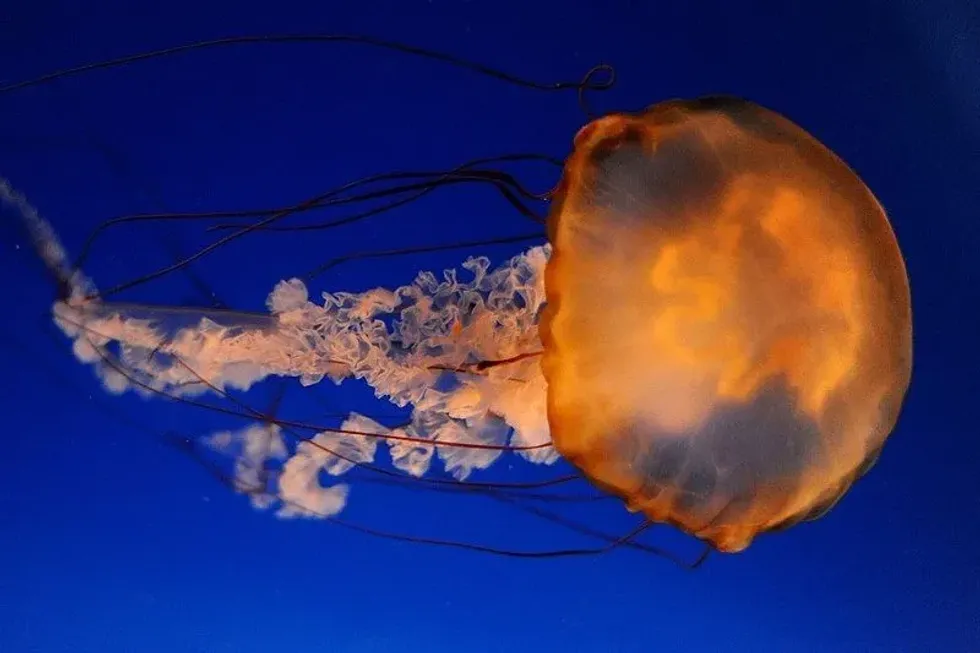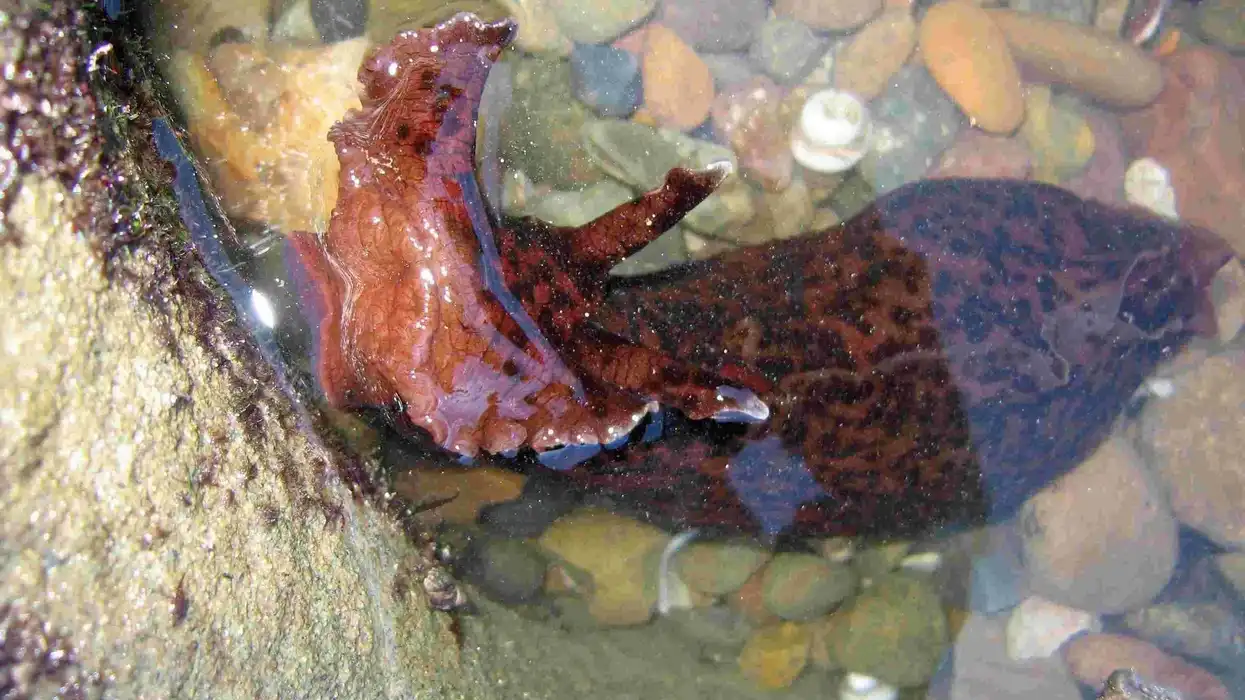The Pacific sea nettle (Chrysaora fuscescens), also called the West Coast sea nettle, is a common jellyfish species that is primarily observed along the Amerian coast of the Pacific Ocean. Not only that, but Pacific sea nettles also form an integral part of the aquarium society of fish and other water animals. Their predators.
like sea turtles and jelly-eating fish species. have decreased following human modification. This led to a growth in the number of jellyfish.
The jellies have also grown in numbers because of their ability to survive in poor water conditions. Therefore, the animal presumably exhibits a stable population trend. Big populations of jellies swim around the California and Oregon coast.
The jellies with developed tentacles and a bell are called medusa. In the medusa stage, the jellies multiply by sexual reproduction while the polyps multiply by asexual reproduction. To learn more facts about these jellies, keep on reading these facts.
For similar content, check out immortal jellyfish and freshwater mussels facts, too.
Pacific Sea Nettle Interesting Facts
What type of animal is a Pacific sea nettle?
The Pacific sea nettle (Chrysaora fuscescens) is a commonly observed sea jelly that is seen along the Pacific coasts of America. These jellies belong to the family of true jellyfish. The Pacific sea nettles are also called the West Coast sea nettle.
What class of animal does a Pacific sea nettle belong to?
The Pacific sea nettles of Semaeostomeae order and Pelagiidae family belong to the class Scyphozoa, the common class for all true jellyfish.
How many Pacific sea nettle is there in the world?
The total number of Pacific sea nettle that exists in the water bodies of the Earth is unknown. The population of these animals has not been evaluated as of yet.
All these facts indicate that the species exhibits an adequately large population size at present, and currently, they do not require rigid conservation methods. Rather, their population seems to have increased in certain parts of its range.
According to some scientists, human interference with the natural ecosystem of coastal areas has resulted in creating favorable conditions for the jellies, which led to an increasing population. Common predators like sea turtles have also reduced widely in numbers. Currently, these jellies exhibit a stable population trend.
Where does a Pacific sea nettle live?
The Pacific sea nettle species are distributed throughout the Pacific coast of North America. Therefore, they are called the Pacific sea nettles.
They are common in the waters of Oregon and California. Some populations also occur towards the north of the Gulf of Alaska and to the south of the Baja Peninsula. They are also found on the western coast of Japan.
What is a Pacific sea nettle's habitat?
The Pacific sea nettle habitat includes coastal areas and bays. These animals are found in open waters serving as prey to much larger fish.
They remain in shallow water like bays and harbors in the winter while they move to deep water in summer. Some of them swim ashore with protruding stinging tentacles by the strong currents of the storm.
Who does the Pacific sea nettle live with?
The Pacific sea nettles live by forming swarms of jellyfish in deep water. A group of jellies is called a smack.
How long does a Pacific sea nettle live?
The average lifespan of Pacific sea nettles ranges from six months to one year in the wild. In an aquarium, they can live for up to 18 months.
How do they reproduce?
A Pacific sea nettle is able to perform both sexual and asexual reproduction. The method by which a medusa fertilizes the eggs is sexual, while the polyps exhibit the asexual method.
The female jellies produce eggs, and they hide these eggs in the mouth. The male jelly releases sperm in the water.
The females fertilize these eggs by catching the released sperm in the water. The fertilized eggs remain connected to the oral arms of the female sea nettles till they transform into planula. These fertilized eggs develop into larvae, and they gradually drift away from the adult sea nettle's body.
The larvae cling themselves on to any hard surface they get in the sea like shells. In that position, the larvae transform into polyps and remain dormant throughout the entire winter.
During the summer and spring, polyp multiplies into several tiny identical sea nettles by a budding process. After a polyp develops completely, it metamorphosizes into a full-grown medusa with tentacles, oral arms, and a bell.
What is their conservation status?
The conservation status of the Pacific sea nettle has not been evaluated by the International Union for Conservation of Nature; these animals are not included in the IUCN Red List. The jellies have been described as fairly common in their range, and they exhibit a stable population trend.
They occur in ample amounts over an extremely large range which keeps them out of the vulnerable criterion.
Sea nettles are survivors; they can easily survive in less oxygenated and dirty water. Therefore, the emissions released by urban runoffs in the ocean and climate change had an adverse effect on the frequency of the Pacific sea nettle.
Pacific Sea Nettle Fun Facts
What does the Pacific sea nettle look like?

The Pacific sea nettles in their medusa stage have a dish-shaped bell. The oral arms and tentacles protrude from the surface of the bell.
They have 24 tentacles that extend from the margin of the bell and four spiral oral arms extending from the center of the bell. The bell also consists of nematocysts called the stinging cells that are used to paralyze their prey.
The stinging cells are distributed all over the surface of the bell. The arms and tentacles are dark in color in comparison to the yellowish bell.
How cute are they?
The Pacific sea nettle is not necessarily cute. These jellies do look majestic when they are in the water though.
How do they communicate?
The process of communication in jellyfish is unknown since they lack sensory tissues and organs.
How big is a Pacific sea nettle?
The size of the diameter of the bell of sea nettles can reach up to 1-3 ft (30.5-91.5 cm), while their oral arms are 12-15 ft (3.7-4.6 m). They are much larger than moon jellyfish.
How fast can a Pacific sea nettle move?
Sea nettles do not have powerful swimming strokes; they can move up and down in water columns. However, their swimming speed has not been determined.
How much does a Pacific sea nettle weigh?
The average weight of Pacific sea nettles is 6.4 oz (181 g).
What are the male and female names of the species?
The male and the female jellies do not have any sex-specific names; both are called Pacific sea nettles.
What would you call a baby Pacific sea nettle?
A jelly in its juvenile stage is called ephyrae.
What do they eat?
The sea nettles have a carnivorous diet. Their diet includes larval fishes, zooplankton, snails, and eggs. Their diet also consists of other species of jellies.
Are they poisonous?
No, sea nettles are not poisonous; however, their sting can be very dangerous for humans.
What eats Pacific sea nettle jellyfish?
In the past, the lives of sea nettles were threatened by some common Pacific sea nettle predators. Sea turtles, large jelly-eating fish species, and birds used to prey on the jellies. However, since humans have started influencing coastal areas, the sea-borne predators have reduced largely from the ocean.
Did you know...
The jellies do not have any brains; they cannot see images. However, ocellis present at the base of tentacles help them to differentiate between dark and light colors.
How deep does the Pacific sea nettle live?
The Pacific sea nettles live deep inside water in the summer, but the range of depth it can reach is unknown.
Can a Pacific sea nettle kill you?
A single sting of the sea nettle's stinging cells is enough to paralyze their prey, but a sea nettle's sting is not enough to kill a human. However, their sting can cause severe reactions in humans.
Here at Kidadl, we have carefully created lots of interesting family-friendly animal facts for everyone to discover! Learn more about some other cnidarians from our blue jellyfish facts, or barrel jellyfish facts pages.
You can even occupy yourself at home by coloring in one of our free printable Pacific sea nettle coloring pages.
Main image by Guillaume Paumier.
Second image by Ray in Manila.









